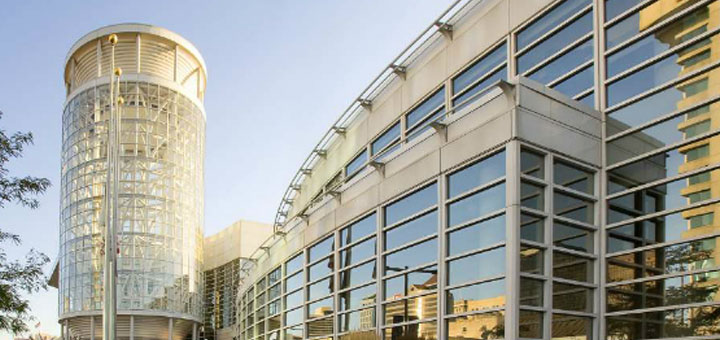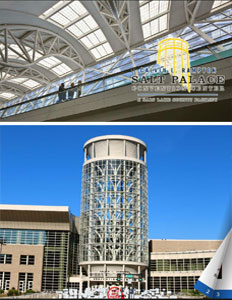The Utah Territory became a part of the United States in 1850, but it wasn’t until 1896 that Utah officially became the nation’s 45th state. And Utahns wanted to show it off. In Salt Lake City, in 1899, the proud citizens there built a great hall out of salt blocks from the Great Salt Lake and brine-soaked timbers. They called it: “Utah’s Wonderful Salt Palace! – The Grandest Amusement Enterprise Ever Attempted.” The edifice sat amid beautiful ponds, gardens, and arbors wrung from the desert sands, and, in the evenings the building was all lit up with new-fangled, electric lights.
“The facility was a pretty spectacular one,” says Dan Hayes, General Manager of today’s Salt Palace Convention Center – the third venue in the city to employ the Salt Palace moniker. “The salt crystallized on the wood and it sparkled at night when it was lit.” Inside the hall, which was capable of holding thousands, there were shows, dances, and dance contests, and outside, in the back, packed crowds watched the world’s fastest bicyclers race around a first-class bicycle racing track. But according to Hayes, the Salt Lake City community also built the hall so that it could display to the world its success in industry. “It was an expo hall for the mining industry, here in town,” says Hayes.
Alas, the first Salt Palace lasted only ten years. It burned to the ground in 1910. The city’s second Salt Palace was a sports and concert arena built in 1969 with seats for 10,725, later expanded to 12,666. It was the home of the Salt Lake Golden Eagles hockey team from 1969-1991; the Utah Stars of the ABA from 1970 to 1975; and the Utah Jazz of the NBA from1979 to 1991. In 1994, after the Jazz moved out, it was partially demolished to make more room for an adjacent exhibition hall that the community built in 1983 in response to public demand for more local events.
“Around 1994, there was discussion about building a new arena for the basketball team and it was about that same time that Salt Lake County, the owner of this venue, decided to jump into the convention center business,” Hayes explains. “So, in 1996, after the arena was taken down, the core of the facility was re-constructed – that’s Exhibit Halls A, B, and C, and a portion of the grand ballroom. Since ’96, we had an expansion in 2000 – we added on more exhibit hall space and grew our ballroom. In 2004, we initiated another expansion – we added about 150,000 square feet of exhibit hall space and about 72,000 of meeting room space. Today’s structure has 515,000 square feet of expo space; about 160,000 square feet of meeting room space; and a 45,000 square foot ballroom.”
The building’s official name is the Calvin L. Rampton Salt Palace Convention Center, named after Utah’s 11th Governor. It is funded by the County of Salt Lake for its operations and capital expenses. “That funding is generally grown off of transient room taxes and other tourism-related taxes,” says Hayes. The Center has approximately 100 full-time employees, and up to 200 part-timers, as necessary. Last year, it hosted 130 events.
“Generally speaking, we do a great deal of national association business that is traditional in the convention marketplace,” says Hayes. “We also do a fair amount of corporate business – a lot that is from the high-tech marketplace. And then, the other large portion of that is from the multi-level marketing or direct sales segment. Utah, and Utah County, and parts of Idaho is home to many direct sales corporations and we do some significant and large events. And then we also get into the traditional, for-profit trade show marketplace, as well.”
Just as the original Salt Palace was a pacesetter in its use of electricity back at the end of the 19th century, one of the salient features of the modern Salt Palace is also related to how it utilizes and, in this case, creates its electricity. On its roof, the County installed 6,006 solar panels, making it one of the nation’s largest rooftop, solar arrays. “Those solar panels generate about 2.3 million kilowatt hours,” says Hayes. “That offsets about 25 percent of our annual consumption of power. And we expect over the lifetime of those solar panels that the average offset will be more about 17 percent, as they degrade over time.” We have just recently initiated our Solar Renewable Energy Credit program whereby we can either gift or sell energy credits to events so that they can claim their event days are powered by 100% renewable energy. This is a great option for meeting planners who are looking to make their meetings more “green.”
While the Center’s solar array certainly helps reduce energy costs, Hayes says that employing the kind of green practices that help sustain the environment, such as making electricity from the sun as opposed to fossil fuels, is an important part of the Utahn character and is well-expressed by the Center’s many sustainability programs and practices. “Salt Lake is fortunate to be in a remarkable, natural environment,” he states. “And the vast majority of people who live here appreciate that natural environment; they’re often engaged in it, directly, in their pastimes, and it’s certainly part of who we are at our core. Our sustainability efforts are part of the ethos – the fabric – of our community.”
Thus, Hayes says that the Center is very aggressive in its drive to reduce, reuse, and recycle. “Cardboard is targeted with great effort and cardboard is the material of choice with respect to exhibitors packing their gear,” he says. “So, there’s a great deal of cardboard in our venue. Beyond that, we also have separate recycling containers throughout the venue that capture mixed recyclables – plastic, aluminum, and paper board – that are all separated out and recycled separately. Last year, we were at about 140,000 pounds of recycled material.”
What the Center doesn’t recycle, it tries to give away. “We capture a great deal of product off of our show floor, whether they be leftover bags, foam core, anything and everything that an exhibitor might not want and that is not traditional trash, and we get that out into our community and re-use it,” he explains. “We formed relationships with a number of community groups, including educational foundations, non-profits and church-sponsored charities. For examples, schools receive foam core signs; bags and lanyards go to a summer camp for kids with cancer; Habitat for Humanity receives carpet and building materials; lost and found items go to a thrift store or to homeless shelters. It’s an incredibly successful program. We launched it about two and a half years ago, and we’ve donated thousands of bags and thousands of feet of foam core.”
The Center has also addressed the greening of its infrastructure. “Ten years ago, we converted all of our exhibit hall lighting to fluorescent, which was a dramatic savings,” Hayes says. “Now, with the advent of LED, we’re converting spaces, yearly, over to LED lighting throughout our venue. Other things we do: our landscape system uses drip irrigation to save about 50 percent in terms of landscape water. We have about 50 percent of our venue, right now, equipped with waterless urinals, and we’re looking to add another 65 waterless urinals next year and that will get us to about a 75 percent conversion in the venue. Each urinal is expected to offset about 40,000 gallons of water per year. So, we take all of those things exceptionally seriously.”
Another sustainable practice has allowed the Center to minimize its paper use. “The biggest thing we’ve done there is for our event management team, the folks who write the BEOs (Banquet Event Orders) or the set-up sheets for each event,” Hayes declares. “In years past, we often had BEOs that were 120 pages long; we were printing reams and reams of paper to communicate to staff. About 18 months ago, we converted that whole program over to a software program, which is, essentially, a web-based spreadsheet, to communicate all of our set-up needs. We equipped all of our managers and supervisors with tablets so they can capture that event need and those event orders. And it has just saved forests of trees. We always look to be early adopters of technology where it can save us money and also save on tolls to the environment.”
Adopting the latest in technology is another way in which the Center continues to serve its clients while staying ahead of the competition. “We have a very robust IT system, here,” Hayes says. “We have a 600 MB dedicated server in the building that’s burstable to 2 GB; all of the back-up end hardware in the building is actually capable of 10 GB. So, as that demand arises in the next few years, we’ll be able to pretty easily build up that bandwidth as needed. That service is also redundant; we have two separate feeds coming into the venue with auto-failovers. Between them, we have 240 Aruba access points throughout the facility – they’re 80.211ac – the latest and greatest. So, in terms of performance, the tethering from a handheld device to an access point is greatly improved with this ac version.”
The Center’s high-tech capabilities have been instrumental in gaining and retaining some important clients who depend on the venue’s powerful systems. “One of them is called Educational Testing Services. It’s a group that comes to us each year. They grade AP exams. They’re a very high-tech group; they push data live to servers in other parts of the country and they have required of us redundancies in our IT system that are just about second-to-none in the industry. We are also, this year, hosting for the second time in four years, the IEEE Super Computing Show. While here, they will build the fastest computer in the world. To facilitate this, the Utah Education Network brings in all the hardware, circuits and bandwidth to make this possible, and then leaves everything at the Salt Palace for our continued use. As a result, we’re an incredibly high-tech venue and one that I’m proud of.”
While Hayes is justifiably proud of the Center’s IT capabilities, as well as its sustainability practices, he realizes that those aspects of the venue are merely there to support the most important part of its mission: customer service. “Where I am focusing a lot of energy, today, and where I think our focus will really separate us, is how do we better service our clients on a day-to-day basis? How do we improve our client interactions, every day? And how do we adopt technology to increase satisfaction with those folks, whether they are attendees in our venue or clients who signed contracts with us?”
Regarding the Center’s clients, Hayes addresses his own questions by pointing out how the Center has recently improved its ability to better interact with the meeting planners who book space at the Salt Palace, sometimes years in advance. “We have launched, just within the last few months, a new program that puts our event managers in our venue in a much earlier and more frequent contact with our clients,” he explains. “In years past, we contracted out events, years out, and our event managers typically engaged that client inside twelve months. We’ve stopped that process and we’re starting to engage our clients on a regular basis as soon as they are contracted – whether with updates or facility changes or planning programs – so they’re getting constant information from us as soon as they’ve signed that contract. All documents and order forms will actually be uploaded on Google Drive, giving clients direct access and the ability to work in a “live” document with their Event Manager. This new process eliminates the need for emailing attachments, printing, or faxing documents. Plus, it increases efficiencies and communication while decreasing the chance of errors. We think that using these tools in this way, and engaging our clients this way, is going to set us apart.”
Finally, Hayes talks about how the Center continually finds ways in which to solicit employee input in an effort to better serve its constituents. “We engage our employees at decision-making levels,” he states. “We have employee-led committees that establish what the values are for our organization: Service for Success, Outreach to our Community, Awareness of Safety, and Responsibility to our Environment. And it’s those values that we consider when we’re making choices, when we’re looking to the future, and when we consider how to improve our operation and make it better. And that is something of great importance and something that, I think, may be unique in our industry.”
Over a hundred years ago, the first Salt Palace in Salt Lake City was unique for its time. Today, the Salt Place Convention Center has taken not only its progenitor’s name, but also its unique characteristics of amusement, industry, and service to the community.
______________________________________
AT A GLANCE
WHO: The Salt Palace Convention Center
WHAT: A full-service convention and meeting facility
WHERE: :Salt Lake City, Utah
WEBSITE: www.visitsaltlake.com/salt-palace-convention-center
PREFERRED VENDORS
Centennial Management Group – www.cmgfacilities.com


